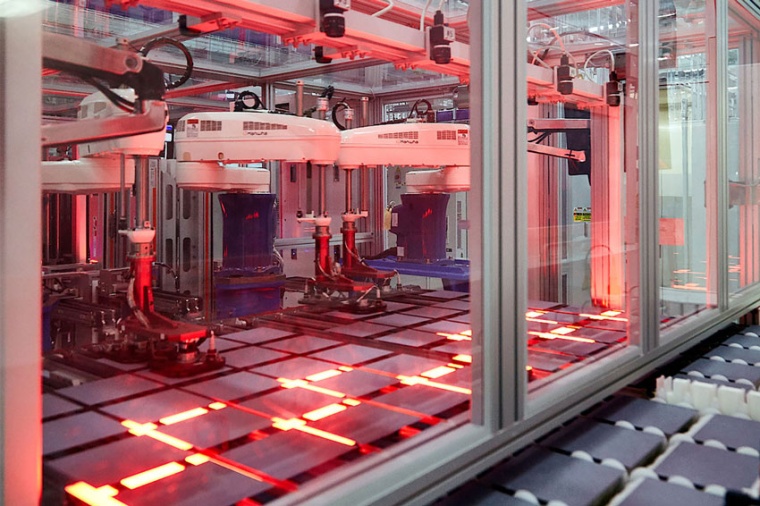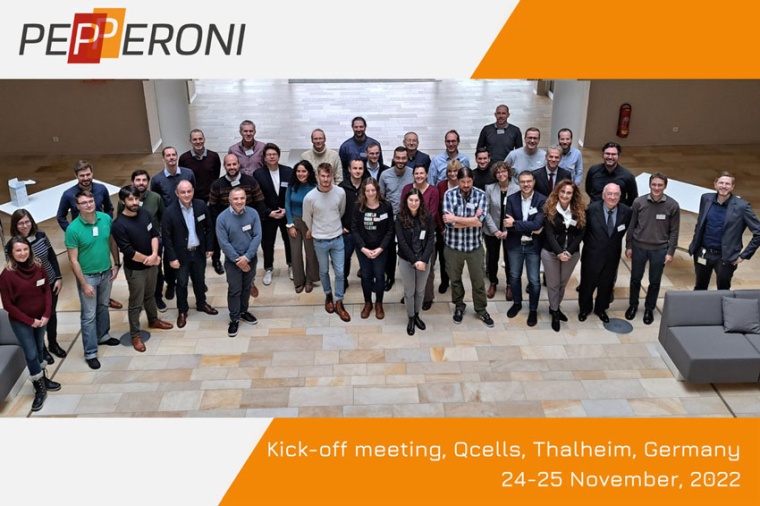European pilot line for tandem solar cell photovoltaics
Pepperoni, a four-year Research and Innovation project co-funded under Horizon Europe and jointly coordinated by Helmholtz-Zentrum Berlin and Qcells, supports Europe in reaching its renewable energy targets.
The project will help advance perovskite/silicon tandem photovoltaics (PV) technology’s journey towards market introduction and mass manufacturing. Pepperoni‘s goal is to identify and address the barriers to tandem solar technology’s market introduction, and ultimately lay the foundations for new production capacity in Europe. A pilot line enabling this development will be established at Qcells’ European headquarters in Thalheim, Germany. The project began on 1 November 2022, with the long-term vision of enabling European industrial leadership on PV production in the global market.


Pepperoni aims to set up a pilot line to develop solar modules with perovskite/silicon (Si) tandem technology. Funding will total approximately 14.5 million euros over four years, with the consortium covering the full value chain of PV innovation. The most widely established solar cell technologies to date are made with silicon, and silicon PV is now one of the cheapest means of electricity production in many parts of the world. The solar industry’s success in recent years has pushed the industry towards the current practical limits of efficiency for silicon technology. To exceed the limits of single-material cells, scientists have proposed to add a complementary one to form ‘tandem’ solar cells.
Pepperoni has selected technology that promises the best ratio of performance over manufacturing costs – silicon/perovskite tandem. Perovskite, a novel class material with a special crystal structure, can be fine-tuned to take advantage of the parts of the solar spectrum that typical silicon PV materials cannot utilize very efficiently, meaning they make excellent hybrid-tandem partners. Pepperoni will ‘spice up’ industrial silicon cells with a perovskite top cell. This tandem design benefits from the industrial expertise of silicon PV and extends the range of attainable power conversion efficiency (PCE) beyond the practical limits of silicon.
Increasing the PCE of solar cells is important for two reasons. In the long run, it is the most effective way to reduce the levelized cost of electricity (LCOE). And in the short term, it is the best way to promote photovoltaics for applications where space is limited e.g., rooftops, facades, or vehicles.
Within Pepperoni, a pilot line for the development of industrial-type tandem cells and modules will be established at the Qcells European headquarters in Thalheim, Germany, and will feature innovative equipment, processes and materials to produce high-efficiency tandem cells and modules The project aims to scale up the active area of perovskite/Si tandems from the 1 cm² of today’s record devices to industry-relevant dimensions. Pepperoni’s approach promises a fast and cost-competitive route to mass-production of PV modules of high performance and long durability.
Fabian Fertig, director global R&D wafer and cells at Qcells, said: “This research promises to break new ground in the advancement of perovskite-silicon tandem solar cell and module technology. At a time of unprecedented pressures on the current energy system, it is exciting to realize this first and transformative step towards industrial-scale manufacturing of next-generation PV technology in Europe.”
Pepperoni proposes to use a type of silicon bottom cell, which is based on technology that is already produced at a gigawatt scale globally: ‘Qantum’ technology, which was first introduced in 2012 by the project partner leading the technology development, Qcells. As part of its proprietary technology, Qcells has developed several innovations, from first ideas to mass production readiness, and successfully transferred these innovations into high-volume production. Examples include the introduction of PERC-like (passivated emitter and rear cell) solar cell technology, as well as half-cell, wire-based interconnection and zero-gap solar module technology. Recently, Qcells has expanded its technology by developing a passivating contact technology (Qantum neo) to further boost solar cell and module efficiency. It enables the company’s unique yield security, which offers a number of additional benefits regarding cell performance and reliability. Applying the same proven product requirements to the Pepperoni tandem technology is a crucial task of the project.
Bernd Stannowski, head of group Industry compatible processes, solar cells and modules at HZB explains: “At HZB we have developed the tandem technology to world-record efficiency level on lab scale. We are now looking forward to cooperate in the Pepperoni consortium with partners from science and industry to jointly scale this new and very promising technology up and transfer it to industry.”
Pepperoni combines European knowledge and expertise from fundamental research to small-scale testing and development of solar cells all the way to high-throughput industrial manufacturing of large solar modules. The Pepperoni consortium counts 17 partners from twelve countries spanning across Europe who came together for the project’s kick-off meeting on 24 and 25 November at Qcells in Thalheim, Germany, among them Von Ardenne, Mondragon Assembly, and CSEM.
Company
Helmholtz Zentrum BerlinAlbert-Einstein-Str. 15
12489 Berlin
Germany
most read

Teledyne Vision Solutions: Camera manufacturer unifies machine vision portfolio
Teledyne combines the various machine vision technologies, including 1D, 2D and 3D cameras, under the umbrella of "Teledyne Vision Solutions".

Machine Safety 2026: The Five Most Important Trends for Eutomation Engineers
Digitalization and automation continue to drive mechanical engineering forward - and with them, the requirements for functional safety and cyber security are increasing. For automation engineers, this means that machine safety is becoming a holistic concept.

United Robotics Group restructures
The company focuses on the healthcare industry and innovation.

HMS Networks takes over Industrial Communications division from Molex
This strategic acquisition includes intellectual property in hardware and software, a product portfolio with network cards and software stacks, as well as customer relationships in the USA and Japan.

First access for external users to the QSolid quantum computer
The prototype of the QSolid quantum computer was successfully integrated into the JUNIQ infrastructure of the Jülich Supercomputing Center.






